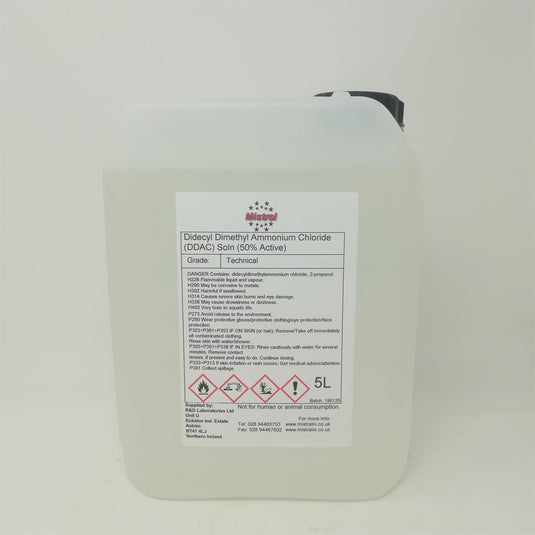DIDECYL DIMETHYL AMMONIUM CHLORIDE (C8-10)
1-Decanaminium / Didecyldimonium chloride
DDAC (C8-C10) 50% Solution
Technical grade
DDAC 50 is a twin chain quaternary ammonium. It is a modern and safe biocide. It features broad spectrum activity against both gram positive and gram negative bacteria, fungicide and mildewcide, active against enveloped viruses (e.g. Hepatitis B, HIV), tolerance for anionic contaminants, high tolerance to hard water, maintains efficacy in presence of heavy organic soiling such as blood and protein, good surfactant and wetting properties. It has an amine content of approximately 1.5%.
Broad spectrum of activity against both gram positive and gram negative bacteria.
Fungicide, algaecide and mildewcide.
Active against enveloped viruses (e.g. Hepatitis B, HIV).
High tolerance to hard water.
Maintains efficacy in presence of heavy organic soiling such as blood and protein.
Good surfactant and wetting properties.
PLEASE NOTE: We do not sell this product for use as a Biocidal Product. It is the responsibility of the user to obtain registration for formulations based on DDAC 50 when intended use is as a biocide, appropriate to its recommended application and the country or territory in which it will be used.
DDAC is no longer permitted for the use as, or in preparations for the treatment of moss as moss has been reclassified as a plant and comes under the plant protection legislation.
Chemical and Physical properties
UN No.: 2920
INCI-Name Didecyldimonium chloride
Appearance: Pale, clear liquid
Cationic Content: 50.0 – 52.5%
Colour (APHA): <100
Amine value: <2 mg/g
Solubility: Fully soluble in water, low molecular weight alcohols and ketones.
Stability in Application*: Stable in the presence of light, over the pH range 2 - 10 and at up to 120°C.
Use areas:
Disinfectant and disinfectant cleaner for hospitals, food industry, industrial kitchens
Laundry disinfectant.
Wood treatment (sap stain and decay).
Water treatment (swimming pools, cooling towers etc). For the prevention of algae and “slime” in swimming pools, industrial water reservoirs and cooling towers
Slimicide (paper industry).
Algaecide / Fungicide (walls, patios, decking etc).
DDAC50 is a strongly cationic product and therefore incompatible with formulations containing anionic components. It may, however, be used with other cationic or non-ionic compounds. Users are therefore strongly advised to carry out their compatibility tests prior to initial application.
Please note that the pH of DDAC50 on production is in the range 6.5 – 8.0 (2% aqueous solution) but this may drift downwards with time. Such variation has no effect on the product’s biocidal properties
PLEASE NOTE: This product is not for human or animal consumption.
Biocidal Properties
The active agent of DDAC50 typically exhibits the highest biocidal efficacy of all quaternary compounds. The performance advantage is especially evident in the presence of hard water and organic soiling, compared with simple Benzalkonium chloride quaternaries. Given below are examples of relevant organisms against which it is particularly effective:
Test Micro-organisms:
Bacteria:
Bacillus cereus
Bacillus strearothermophilus
Bacillus subtilis
Corynebacterium diphtheriae
Desulphovibrio desulphuricans
Enterobacter aerogenes
Enterococcus faecium
Escherichia coli
Klebsiella pneumoniae
Leuconostoc mesenteroides
Listeria monocytogenes
Mycobacterium smegmatis
Pseudomonas aeruginosa
Pseudomonas cepacia
Proteus mirabilis
Proteus vulgaris
Salmonella choleraesuis
Salmonella typhi
Shigella somnei
Staphylococcus aureus
Streptococcus faecalis
Streptococcus pneumoniae
Streptococcus pyogenes
Vibrio cholerae
Moulds/Yeasts
Alternaria alternata
Aspergillus niger
Apergillus versicolor
Aureobasidium pullulans
Candida albicans
Chaetomium globosum
Cladosporidium cladosporoides
Coniophora puteana
Coriolus versicolor
Epidermophyton floccosum
Gleophylum trabeum
Microsporum canis
Microsporum gypseum
Penicillium glaucum
Penicillium verrucosum
Poria placenta
Saccharomyces cerevisiae
Trametes versicolor
Trichoderma viride
Trichophyton mentagrophytes
Algae
Chlorella pyrenoidosa
Chlorella vulgaris
Nostoc commune
Phormidium faveolarum
Phormidium inundatum
Phormidium uncinatum
Scenedesmus obliquus
Scenedesmus vacuolatus
Viruses
Adenovirus
Hepatitis B
Herpes virus
HIV-1
Newcastle Disease
Rhabdovirus
